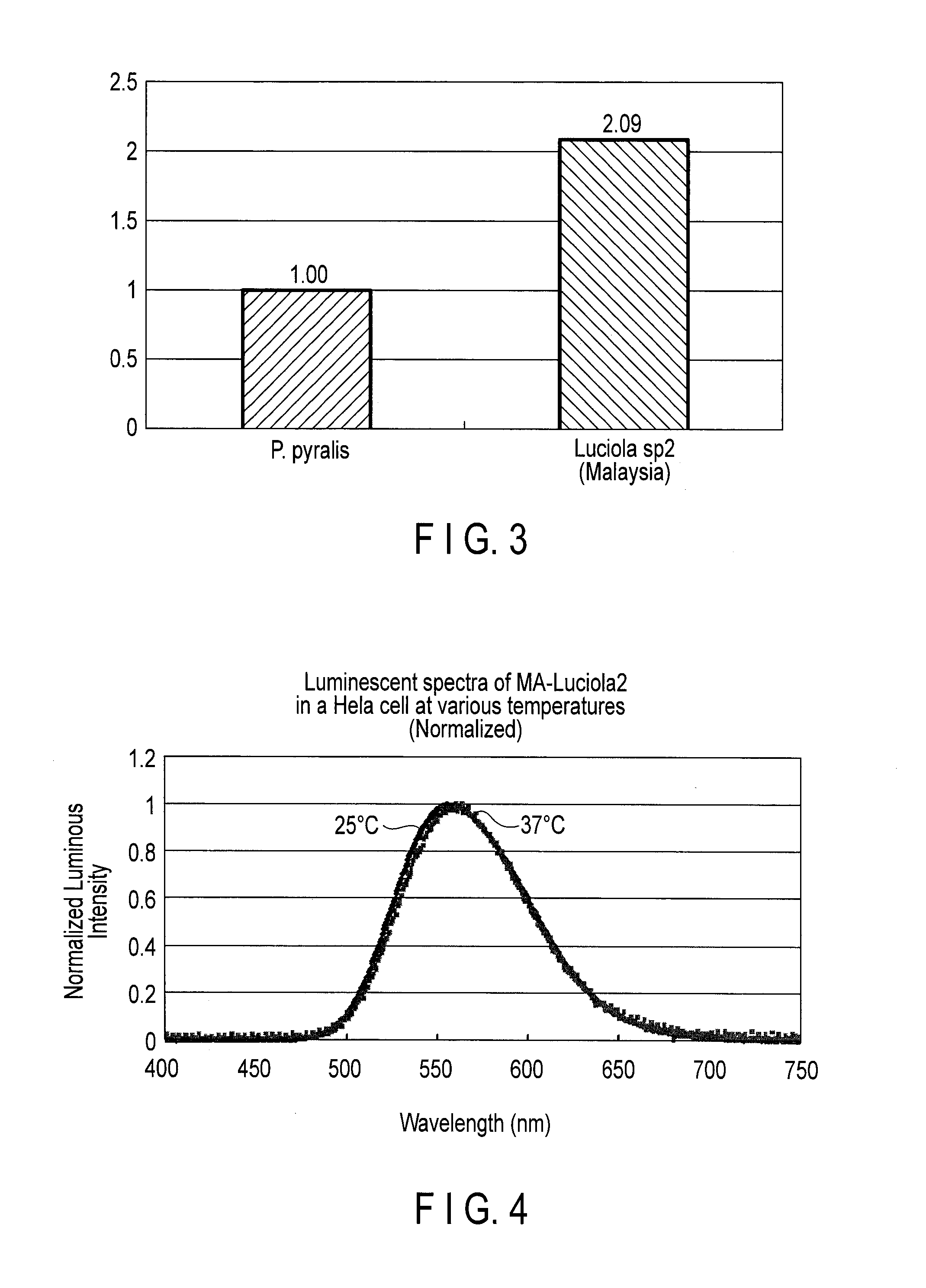Firefly luciferase
a technology of luciferase and firefly, which is applied in the field of firefly luciferase, can solve the problems of inability to real-time image pickup and limited research use of luminescent samples, and achieve the effects of time-course observation, short exposure time necessary for luminescent image pickup, and high luminous intensity
- Summary
- Abstract
- Description
- Claims
- Application Information
AI Technical Summary
Benefits of technology
Problems solved by technology
Method used
Image
Examples
example 1
[0042]1. Materials
[0043]Firefly larvae collected in the state of Perak, Malaysia were used as materials. The used firefly has been proved to belong to genus Luciola, but a scientific name has not been assigned thereto. In this disclosure, the species is referred to as Luciola sp2 or sp2.
[0044]2. Extraction of Total RNA and Synthesis of cDNA
[0045]A luminescent organ was cut off from firefly larvae. To Lysing Matrix D tube (MP-Biomedicals, LLP), which is a tube containing beads for homogenizing tissues and cells, added were the collected luminescent organ and 1 mL of total RNA extraction reagent TRIzol Reagent (Invitrogen). The tube was installed in a homogenization system FastPrep 24 (MP-Biomedicals, LLP) or FastPrep FP100A (MP-Biomedicals Co., Ltd.), and the firefly luminescent organ was homogenized in the reagent at speed of 6.5 m / s and time of 45 seconds. Upon completion thereof, the tube was taken out from the system and placed on ice for 30 minutes. Con...
example 2
Determination of Enzymatic Parameters of Novel Luciferase
[0074]1. Protein Expression of Novel Firefly Luciferase Gene
[0075]For expressing firefly luciferase gene in E. coli, it was introduced into a pRSET-B vector (Invitrogen). According to the standard method, the gene expression vector was constructed by experiments described below.
[0076]1-1. Modification of Recognition Site of Restriction Enzyme of Novel Firefly Luciferase Gene
[0077]According to the base sequence determined as described above, the novel luciferase gene contains the recognition sequence of restriction enzymes BamHI and EcoRI. The genetic modification was carried out so that the amino acid sequence of luciferase was maintained and the recognition sequences in these base sequences were removed. This treatment was carried out for the purpose of facilitating the introduction of luciferase gene into an expression vector which is explained below. The introduction of genetic mutation was carried out by following the meth...
example 3
Measurement of Luminous Intensity
[0105]The luminous intensity of SP2 luciferase expressed in a mammal cell (HeLa cell) was compared with that of P. pylaris.
[0106]The fragment of the nucleic acid having the base sequence of SEQ ID NO: 31 and that of Luc2 luciferase of P. pyralis from pGL4(Luc2) vector (Promega co.) were inserted into the pF9A CMV hRluc-neo FlexiR vector (Promega) with multi-cloning sites of SgfI and PmeI. The pF9A vectors were each introduced into HeLa cells by a lipofection method, and D-MEM culture medium was exchanged after 24 hours, and the mutant luciferases were expressed in the cells.
[0107]The luminescence intensity of the cells was measured by the luminescensor (ATTO) with 2 mM D-luciferin.
[0108]Then, the luminescence intensity of each Hela cell was corrected using the luminescence based on Renilla luciferase (hRluc) co-expressed by the SV40 prompter of the pF9A vector (Promega) as an internal standard according to the instruction manual of the Dual-Gol Luci...
PUM
| Property | Measurement | Unit |
|---|---|---|
| pH | aaaaa | aaaaa |
| luminous wavelength | aaaaa | aaaaa |
| luminous wavelength | aaaaa | aaaaa |
Abstract
Description
Claims
Application Information
 Login to View More
Login to View More - R&D
- Intellectual Property
- Life Sciences
- Materials
- Tech Scout
- Unparalleled Data Quality
- Higher Quality Content
- 60% Fewer Hallucinations
Browse by: Latest US Patents, China's latest patents, Technical Efficacy Thesaurus, Application Domain, Technology Topic, Popular Technical Reports.
© 2025 PatSnap. All rights reserved.Legal|Privacy policy|Modern Slavery Act Transparency Statement|Sitemap|About US| Contact US: help@patsnap.com



